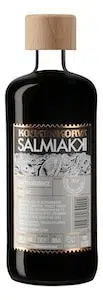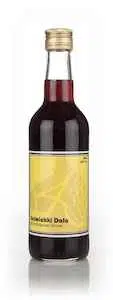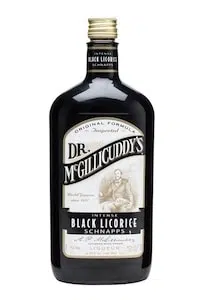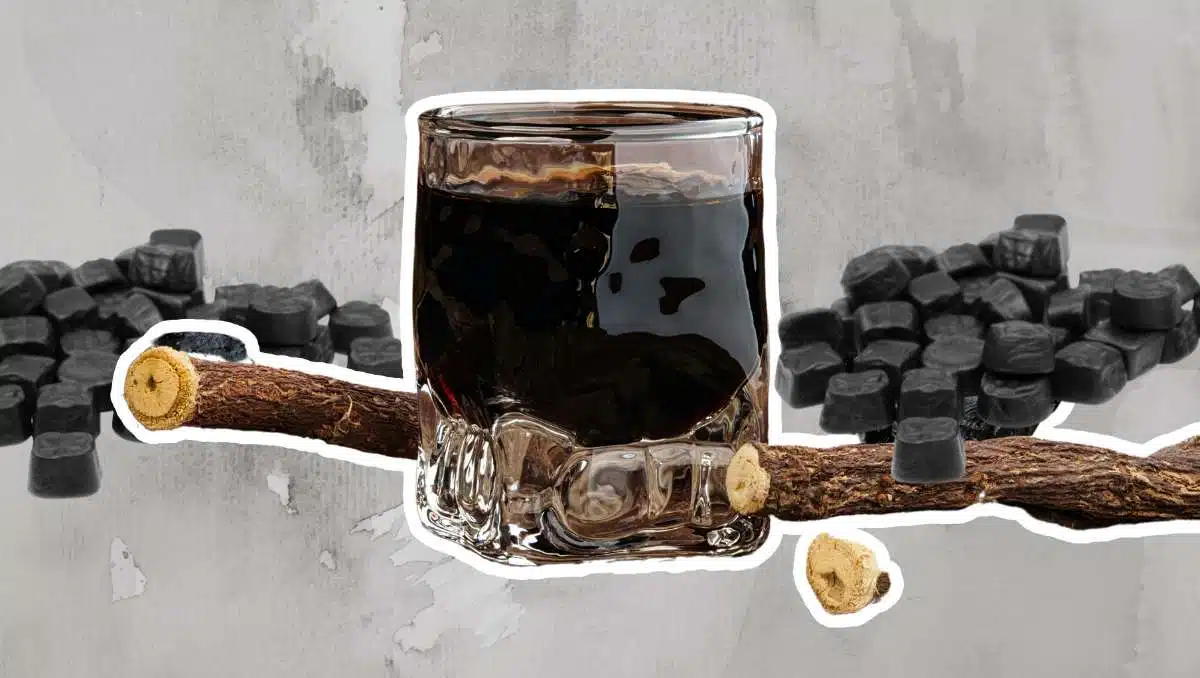Licorice liqueur - or liquorice liqueur (UK) - is a European specialty often consumed chilled after a lavish meal. It is a medium-ABV, sweet, herbal liqueur mainly produced in European countries. It is of dark color and has a thick and syrupy consistency, and people often serve it as a digestif.
Many countries produce signature liqueurs flavored with these herbal ingredients, each with a unique twist. In Italy, for example, licorice liqueur is one of the most effective digestives Italians have to offer. It is also one of the simplest liqueurs to make and does not need months of brewing. In Colombia, aguardiente is the national drink that is distilled from sugar cane and flavored with star anise, giving it a distinct black licorice flavor.
Whether you are a fan of black licorice or not, licorice liqueur is worth a try. Its unique taste and versatility make it a great addition to any home bar or liquor collection. In the following sections, we will explore the history, production, and uses of licorice liqueur and some well-known brands and cocktail recipes to try.
What Does Licorice Taste Like?
Licorice liqueur is a unique and distinctive alcoholic beverage. It is flavored with one of several licorice-flavored herbs, including licorice root, anise seed, hyssop, or star anise. The taste of licorice itself is sweet, with a slightly bitter aftertaste. In Scandinavia, licorice sweets and liqueur often have a salty taste. In Finland, Netherlands, and Greenland, salty licorice is one of the most famous sweets you can get.
The primary compound responsible for the taste of licorice is glycyrrhizin, which is found in the root of the licorice plant. Glycyrrhizin is a natural sweetener that is approximately 50 times sweeter than sugar.
Aniseed is commonly used to infuse many types of alcohol, including absinthe, ouzo, and Sambuca. While licorice and anise have very similar tastes, they are not the same. Licorice has a more complex flavor profile, with a sweet and slightly less bitter taste in comparison to aniseed.
Licorice vs. Anise vs. Star Anise
The ingredients licorice, anise, and star anise are often used interchangeably in cooking and beverages, but they are distinct ingredients with different characteristics. Each herb has a slightly different flavor profile, which can affect the overall taste of the liqueur. This section will explore the differences between these three entities.
- Licorice: Licorice is a root derived from the Glycyrrhiza glabra plant. It is used to aromatize candy, tobacco, and liqueurs. The main flavor compound in licorice is glycyrrhizin, which gives it a subtle sweetness and slightly bitter taste. Licorice root is also used in traditional medicine to treat various ailments.
- Anise (aniseed): Anise is a flowering plant that produces seeds (aniseed) with a distinct licorice-like flavor. Anise-flavored liqueurs, such as absinthe and ouzo, are made by distilling anise seeds. Anise is used in cooking and baking, especially in Mediterranean and Middle Eastern cuisine. The main flavor compound in anise is anethole, which gives it a sweet and spicy taste.
- Star Anise: Star anise is a fruit from the Illicium verum tree. It has a distinct star shape and a licorice-like taste. Star anise is commonly used in Chinese cuisine and is a main ingredient in Chinese five-spice powder. The main flavor compound in star anise is also anethole, which gives it a sweet and spicy taste.
While these three ingredients have similar flavors, they are not interchangeable. Licorice has a more intense and complex flavor than anise or star anise due to the presence of glycyrrhizin. Anise has a sweeter and spicier taste than licorice and star anise. Star anise has a milder licorice flavor than licorice and a sweeter taste than anise.
Best True Licorice Liqueurs
In Scandinavia, especially in Finland, you can find a large selection of licorice liqueurs. Besides these Northern countries, Italy accounts for most of the world's black licorice liqueur production.
If you want to make homemade licorice liqueur, here's an excellent recipe for Italian-style licorice liqueur. But as making liqueur is not for everybody, we also collected some of the best to present in this article.
Here's a list of some of the finest licorice liqueurs out there.
Saamani Salmari

Origin: Finland
ABV: 21%
Saamani Salmari is available in a blue and red expression. Should you just get started with licorice liqueur, opt for the blue one. It's milder in taste but still has an authentic and bittersweet taste of licorice.
The red version is for hard-core licorice lovers. The bold, herbal, bitter, and sweet notes reflect the authentic taste of licorice root. And while that's too much of a flavor bomb for most, connoisseurs love it for delivering the full array of flavors.
Gatta Nera

Origin: Italy
ABV: 19%
Gatta Nera means "black cat." The name alludes to the dark color of black licorice, and it consists of some unusual ingredients. Gatta Nera liqueur is made with Prosecco grappa, licorice, and peppermint extract from plants growing in Calabria.
The licorice and peppermint dominate the taste in a harmoniously balanced way. Sweet, full-bodied, and fresh with exciting bitter accents, Gatta Nera is a sensational digestif for a culinary evening with friends.
Koskenkorva Salmiakki

Origin: Finland
ABV: 32%
The Koskenkorva licorice liqueur was launched in the 1990s. Demand for this liqueur based on Koskenkorva Vodka was so high that it got banned by the Finnish government shortly after its release.
In 1995, the brand released a new and lower-ABV version of the liqueur. This one wasn't banned, and it's still available today. And it is among the top 3 liqueurs sold in Finland.
And rightly so. The flavor of Koskenkorva licorice liqueurs is rich and smooth, with an authentic aroma of salty licorice. Although it's relatively high ABV for a liqueur, the alcoholic bite from the vodka is barely detectable. Instead, it adds warmth to the liqueur, making it even better.
Bottega Licorice liqueur

Origin: Italy
ABV: 25%
Bottega Licorice liqueur certainly has one of the most elegant bottles. And the liqueur also tastes deliciously complex and smooth.
The base for Bottega's licorice liqueur is roots harvested on the Ionian coast that are transformed into licorice powder to flavor the liqueur. The result is a dark and velvety liqueur with a rich taste that works best as a digestif, in cocktails, or as an alcoholic addition to desserts.
Salmiakki Dala

Origin: Sweden
ABV: 38%
Inspired by the salty licorice sweets, this Swedish version of a licorice liqueur features more than just licorice. Additional ingredients like saffron, aloe, sal ammoniac, chicory, and anise add some extra complexity.
Salmiakki Dala is somewhat of a licorice-forward Scandinavian take on an Amaro. And for better balancing taste and color, caramel is added to the mix. All in all, it's a perfectly smooth liqueur that also works great in cocktails and as a salty Amaro substitute.
Dr McGillicuddys licorice liqueur

Origin: Canada
ABV: 30%
Canada is certainly not the first country you think of when talking about licorice liquor. However, Dr. McGillicuddy's licorice liqueur is a nice take on it. The taste is less intense and complex than other bottles in this list, but it's a great entry-level option for everyone new to licorice.
The retro-design of the bottle and label take you back to the prohibition era. A time when alcoholic liquids were often consumed for medical reasons as there were no legally allowed alternatives.
Fisk licorice liqueur

Origin: Denmark
ABV: 30%
Fisk is an expression from a Northern European country. The family-owned company produces its rich licorice liqueur in Denmark. Fisk is also often called the "inofficial spirit of Scandinavia."
Based on Vodka, Fisk gets flavored with licorice and additional botanicals. Similar to Salmkiakki Dala, supplementary ingredients go into the recipe, including eucalyptus and menthol.
Apart from drinking it as a shot, the licorice liqueur is beautifully suited for serving it with coke; -Reminding of a Latin American special, the Fernet and Coke, aka Fernandito.
Licorice & Anise-flavored Liqueurs around the world
Licorice and anise-flavored liqueurs are popular all over the world. These liqueurs are made from a variety of ingredients, including licorice root, anise, and other herbs and spices, and served as a digestif or aperitif.
Sambuca (Italy)
Sambuca is a famous Italian liqueur flavored with anise, dill, and elderflower. It is often served as a shot garnished with a coffee bean and is sometimes set on fire before being consumed.
Sambuca is also a common ingredient in cocktails, such as the Sambuca Sour.
Absinthe (France)
Absinthe is a highly alcoholic anise-flavored spirit that is traditionally made from wormwood, anise, and fennel. It was banned in many countries for many years due to its alleged hallucinogenic properties, but it has recently become legal again in almost all countries.
Absinthe is either served with a sugar cube and ice-cold water, turning the drink milky white, or the sugar cube is drenched in absinthe and set on fire. The latter version is predominantly performed in the Czech Republic using local absinthe products (Bohemian absinthe). mostly
Aguardiente (Colombia)
Aguardiente is a popular Colombian sugar cane spirit flavored with anise and other plants and spices. Colombians drink it as a shot, followed by a chaser of fruit or beer.
In contrast to other products on this list, Aguardiente is not sweet. As it's made from sugar cane, bartenders occasionally use it as a substitute for rum in cocktails.
Salmiakki (Finland)
Salmiakki is a Finnish liqueur flavored with licorice root and ammonium chloride, which gives it a salty licorice taste. It is often served as a shot and occasionally mixed with other spirits, such as vodka.
The taste is distinctly bitter, salty, and sweet - making for a highly unusual flavor combination.
(Dry) Anisette (France)
Anisette is one of the most classic French liqueurs flavored with anise. It is a traditional aperitif or digestif and is sometimes also used in cocktails. Dry anisette has a lower sugar content than regular anisette.
Chinchón (Spain)
Chinchón is a beloved anise-flavored liqueur originating from the Spanish town of the same name. This exquisite liquor is crafted using a blend of carefully selected herbs and spices, resulting in a distinct and aromatic flavor profile.
The liqueur's roots in the picturesque town of Chinchón add to its allure, making it a delightful choice for sipping on its own or as a key ingredient in various classic cocktails.
Arak (Lebanon)
Arak is a traditional Lebanese spirit with a rich history and cultural significance. This anise-flavored liquor is meticulously crafted from fermented grapes and is an integral part of Lebanese culinary and social traditions.
When mixed with water, arak undergoes a mesmerizing transformation, turning from transparent to a milky-white color, a phenomenon known as "louche."
Its unique flavor and ritualistic preparation make arak a cherished and iconic spirit, enjoyed by locals and visitors as they gather to share meals and create lasting memories in the heart of Lebanon.
Mastiha (Greece)
Mastiha, also known as mastica, mastika, or mastic, is a distinctive Greek liqueur with a long history. It is made from the resin of the mastic tree found on the Greek island of Chios.
Mastiha has a unique and refreshing flavor profile, characterized by its resinous and herbal notes, a subtle piney flavor with a touch of sweetness.
This traditional spirit holds cultural significance in Greek traditions and is often enjoyed as an after-dinner digestif or used in culinary creations.
Pernod (France)
Pernod is a famous liqueur from Pernod Ricard, known for its refreshing anise flavor. Crafted with a blend of aromatic herbal ingredients and spices. It's great for sipping neat or in a range of cocktails, captivating spirits enthusiasts worldwide.
It was once created as a substitute for absinthe when the green fairy was banned in the 1920s.
Ouzo (Greece)
Ouzo is a prevalent Greek liqueur made with anise, clove, and cinnamon. It is often served as an aperitif or a digestif and is typically mixed with ice or cold water, which turns the drink cloudy white (louche).
Ouzo is also used in cooking, particularly in marinades and sauces.
Raki (Turkey)
Raki, also known as "Lion's Milk," is a popular alcoholic beverage enjoyed in various regions around the world. Its origins can be traced back to Turkey, the Middle East, and the Mediterranean, where it is often considered a symbol of hospitality and friendship.
The list of ingredients includes grapes, raisins, or other fruits. Its taste and alcohol content can vary depending on the region and distillation process.
Raki is best when served in social gatherings diluted with water, and its shared consumption fosters a sense of camaraderie and joy among friends and family.
Unicum (Hungary)
Unicum is a renowned Hungarian herbal liqueur with a history spanning over two centuries. This dark and bitter spirit is made from a secret blend of more than 40 carefully selected herbs and spices, providing a distinctive and complex flavor profile yet anise is certainly the dominant flavor.
Unicum is deeply rooted in Hungarian culture and is a traditional digestif after meals. Its unique taste and long-standing legacy have made it a symbol of Hungarian heritage, cherished by locals and embraced by adventurous palates seeking an authentic and memorable drinking experience.
Pastis (France)
Pastis is a classic French liqueur with a rich heritage dating back to the 19th century. This anise-flavored spirit is renowned for its vibrant green color and is traditionally served as an aperitif. To enjoy Pastis, it is usually diluted with water, which results in a milky-white appearance known as "louche."
The distinctive taste of Pastis is characterized by the combination of aniseed, licorice, and various aromatic herbs, creating a refreshing and herbal flavor profile. This iconic liqueur holds a special place in French culture, and its convivial consumption during social gatherings embodies the essence of the French joie de vivre.
Xtabentún (Mexico)
Xtabentún is a unique and flavorful liqueur hailing from the Yucatan Peninsula in Mexico. This traditional Mayan spirit is crafted from a blend of honey, anise, and the fermented nectar of the xtabentún flower, which is native to the region.
The result is a sweet and aromatic liqueur with hints of herbal and floral notes. Xtabentún is deeply rooted in Mayan culture and is often enjoyed as a delightful after-dinner treat or used to create exotic cocktails. Its distinctive taste and cultural significance make it a true gem among liqueur enthusiasts seeking a taste of the rich Mexican heritage.
Patxaran (Spain)
Patxaran, also known as Patxarana, is a delightful liqueur originating from the Basque region of Spain. This traditional spirit is made by macerating sloe berries, which are small dark fruits, with anise-flavored liquor and sweetening it with sugar.
The result is a luscious and ruby-red liqueur with a harmonious blend of fruity, herbal, and slightly spicy flavors. Patxaran is deeply ingrained in Basque culture and is often savored as a digestif after meals or enjoyed in social gatherings with friends and family.
Other interesting liqueurs
- Safari liqueur - Made of exotic tropical fruits-
- Branca Menta - The minty take on the iconic herbal liqueur.
- The best Peanut Butter Whiskey liqueurs.
- Galliano L'Autentico - An authentic Italian herbal liqueur.
- Midori Musk Melon liqueur - A popular melon flavored liqueur from Japan.

